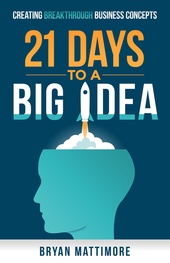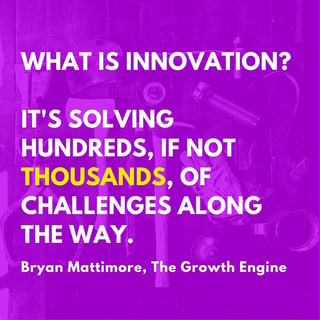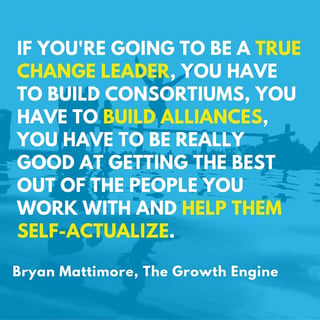While a rare few are prolific generators of innovative ideas, for most of us, brainstorming is a grueling mental exercise with hit or miss results. But generating new ideas isn't solely reserved for the creative types. Just as you need to lift weights a couple times a week to build muscle, coming up with new ideas takes dedication and practice.
For this Transformation Talk, we spoke with a change leader who helps companies and executives create fresh ideas for highly profitable new products, services and strategic planning.
Bryan Mattimore, the Cofounder and “Chief Idea Guy” of the Growth Engine Company, a 16-year old innovation agency based in Connecticut, has facilitated over a thousand  brainstorming sessions, moderated over 500 creative focus groups, and managed over 200 successful innovation projects for a wide variety of Fortune 500 clients.
brainstorming sessions, moderated over 500 creative focus groups, and managed over 200 successful innovation projects for a wide variety of Fortune 500 clients.
In addition to dozens of published articles and webinars, he's authored three books on business creativity and innovation process: 21 Days to a Big Idea: Creating Breakthrough Business Concepts, Idea Stormers: How to Lead and Inspire Creative Breakthroughs and 99% Inspiration: A Real World Guide to Business Creativity.
He had a lot of practical advice to share with Kintone readers on how to turn ourselves and our teams into a garden of great ideas.
Kintone: First tell me a bit about the concept behind “21 Days To a Big Idea: Creating Breakthrough Business Concepts” and what led you to write this book?
BM: A couple things. Bob Dorf, who is one of the authors of "The Startup Owner's Manual," teaches at Columbia and Skolkovo University in Moscow, came to me and said, "My entrepreneurial students in business school...their ideas aren't very good, frankly. I can help them get them to market successfully, but their ideas aren't so good." So, he said, "Could you come up with a process or an approach that would help them get better 'big ideas'?"
That's what really led to the book because what I did was a 21-day experiment on myself where I created a big idea every day for 21 days. Turns out it's really hard to do, but I did it because I wanted to walk my own talk and I knew I would come up with a process for helping other people to do it.
Kintone: What kinds of ideas do the techniques in your book help people come up with?
BM: Some of the techniques in the book like questioning assumptions or 20 questions or even problem redefinition are really powerful for getting individuals and teams to break through their own limitations. They're particularly good for coming up with new strategies for a business, as well as new sales and marketing programs. I think just in general, when people can bring in new ideas, they can move the organization to new arenas, to new business models, to new ways of going to market, and to new positionings for their products. All these wonderful things that can be important when competition gets tough, sales are down, they don't have the talent, or whatever it is. They can use these processes to "solve" those problems. So, I think the bigger message is that the ideation techniques and thought strategies in the book are good not only for just new products, but a big idea could be a marketing program, a sales program, even, frankly, creative cost-cutting.
Kintone: You talk about ideation a lot in your book. What’s the difference between that and brainstorming?
BM: Brainstorming is considered the generic of, "Let's get together and come up with ideas." The basic two rules are withhold judgment, sometimes said as, "There are no bad ideas," and of course, there are. Most of the ideas are bad. But rule number one is: withhold judgment; and  number two: quantity will equal quality. So, generate a lot of ideas, and from those, you'll get some that are really good or okay.
number two: quantity will equal quality. So, generate a lot of ideas, and from those, you'll get some that are really good or okay.
That's basic brainstorming, but since the late 1930s, there have been hundreds and hundreds of techniques that have been invented and even our company, Growth Engine, and myself and Gary Fraser, we've invented some of these new techniques to help people and teams generate new ideas. The generic description of all these individual and group creative thinking and idea generation techniques are now called ideation, appropriately.
There have been studies that have shown that brainstorming isn't particularly effective, and that's true because if you've been working on an Oreo cookie for 100 years, to go into a room and say, "Who's got some Oreo cookie ideas?" isn't particularly helpful. What you need to do is use stimuli and stimulus to trigger those new ideas. We actually worked on Oreo cookies and also Chips Ahoy, and we would bring in all kinds of stimuli. It could be dessert menus or dessert books. It could be names of exotic cocktails. We researched menus from the turn of the century and used those to trigger ideas. The whole idea is that with this extra stimulus, that's the way to trigger very new ideas.
FREE DOWNLOAD: Ideation Worksheet with Techniques to Jump Start Your Next Brainstorming Session
Generally, when you're doing ideation, you've got about 10% to maybe 15% of the ideas that you generate in a day are going to be any good. So, if you generate 200 new Oreo ideas, you're going to get maybe 20 to 30 that are really quite good. So, it's about a 10% ratio of really good ideas, or said another way, 90% of the ideas are not good. Those are the numbers you have to deal with when you're doing this work, and that's just the way it works. You have to be open to all those bad ideas, or not useful ideas.
Kintone: What is your go-to technique when you're in need of inspiration?
BM: It's important to have cross-functional teams. It's important to have people with different talents. Same old, same old, you're going to get the same old, same old, right? And sometimes clients will say, "Who should we bring into an ideation or brainstorming session?" and I usually say, well, bring your most creative people! And they say, "What do you mean?" For example, your admin. over there writes poetry. Bring her in.
Cross-functionality is important, but the other thing, too, is that sometimes you can go beyond just an internal focus. You can get people from other departments, you can get suppliers to come in, you can get your agencies to come in. We've had creative consumers come in. We've had trend experts and so on. The whole idea is you want to get people who have different perspectives than you do, who have different life experiences, who have different subject areas of expertise. All of that is critical for getting breakthrough ideas.
Kintone: What's your favorite technique for generating ideas in a short amount of time?
BM: My two favorite techniques -- one we invented is called "triggered brain-walking," where you set up ideation stations around the room, and it's a better way to do brainstorming. When you have all the people at ideation stations, and they're  rotating and building on each other's ideas, you have the advantage of brainstorming while everybody is working at the same time. Also, you don't have one person talking and 20 people listening. It's a much more productive technique than just conventional brainstorming, and the trigger part of that is we trigger them with stimulus.
rotating and building on each other's ideas, you have the advantage of brainstorming while everybody is working at the same time. Also, you don't have one person talking and 20 people listening. It's a much more productive technique than just conventional brainstorming, and the trigger part of that is we trigger them with stimulus.
We could trigger ideas with target market wishing, or pictures, or keywords, or interesting expressions, all related to the task we're working on. That's one of my favorite techniques because it's incredibly productive, and everybody gets involved. It gets over the challenge of introverts versus extroverts.
And the other one is either semantic intuition or problem redefinition (Download Worksheet) and that one's basically about redefining your challenge in thousands or tens of thousands of different ways to get new ideas.
Kintone: A lot of what drives our Transformation Talk series is sharing definitions of what makes a good change leader. What would you say?
BM: I wrote a piece a while back championing the idea of a "facilitating leader," and I think that's still an important idea. The best leaders, even the super-bosses, are people who are eliciting and encouraging ideas from their coworkers. One way to do that is to be aware and know how to use these creative techniques that we use in our work. The ability to question assumptions when you're leading with a team that's stuck, and you, as the facilitating leader or change agent, can open up people's minds to new possibilities when they're stuck because you're aware of these techniques and you know that they can be used to move people out of what they consider impossible binds.
It's incumbent on leaders of the future to be aware of, and to practice, and to share, and to popularize within the organization these different kinds of thinking styles or these different techniques that will encourage different kinds of thinking. I've labeled that as the "facilitating leader" who knows these techniques, who encourages the techniques, who uses the techniques on a daily basis, and not just with groups. These are in one-on-one and even among themselves when they feel that they're stuck. It's much easier to be an agent of change because you are always looking for new and better ways to do things. That's the nature of change because there's tremendous resistance to change.
 And so, it's one thing getting the big idea. But the bigger challenge is how you make that idea happen, both inside the organization and out. If you have all these thinking methodologies, you can innovate your ideas more successfully, meaning you can make those ideas happen. Once you have your big ideas, now the work really begins, and if you're familiar with all these different thinking methodologies, you're going to be in a much better position to really affect change because what is innovation? It's solving hundreds, if not thousands, of challenges along the way.
And so, it's one thing getting the big idea. But the bigger challenge is how you make that idea happen, both inside the organization and out. If you have all these thinking methodologies, you can innovate your ideas more successfully, meaning you can make those ideas happen. Once you have your big ideas, now the work really begins, and if you're familiar with all these different thinking methodologies, you're going to be in a much better position to really affect change because what is innovation? It's solving hundreds, if not thousands, of challenges along the way.
You have a marketing challenge, you have a sales challenge, you have resistance with customers and so on. You have all the politics and all the natural things that happen when you're trying to create something new, and so, if you're going to be a true change leader, you have to build consortiums, you have to build alliances, you have to be really good at getting the best out of the people you work with and help them self-actualize. All those things are important and critical to making new things happen, and if you have these methodologies, if you're familiar with them and use them, it's going to make your work a lot easier.
Learn more about Bryan and his work here.
Do you know someone who’s particularly fantastic at business transformation? Is a master of change management? A leader in teamwork? Nominate them — or better yet, nominate yourself (c’mon now, you’re awesome!) to be featured in our Transformation Talk series. Just send Nicole an email: nicole@kintone.com. Or send us a message on Twitter @kintone
About the Author
Nicole is Director of Marketing at Kintone, with 10+ years experience in content strategy, campaign management, lead acquisition and building positive work cultures of empowered, purpose-driven team members. She spent seven years as a journalist, previously serving as a CBS San Francisco digital producer, NPR contributor, Patagon Journal deputy editor and reporter for several publications, including the Chicago Tribune. She's passionate about the tech for good space, social entrepreneurship and women leadership. On the weekends, you’ll likely find her putting her Master Gardener skills to use in at community gardens in Oakland.











